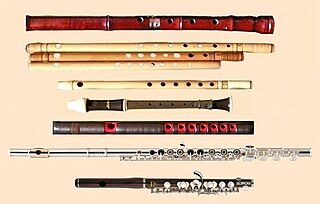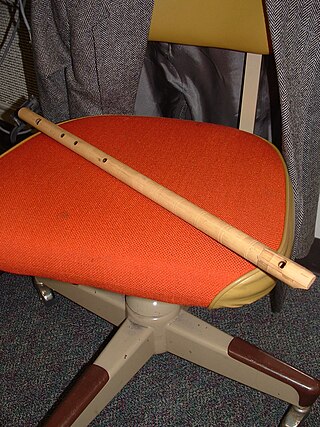
The flute is a member of a family of musical instruments in the woodwind group. Like all woodwinds, flutes are aerophones, producing sound with a vibrating column of air. Unlike woodwind instruments with reeds, a flute produces sound when the player's air flows across an opening. In the Hornbostel–Sachs classification system, flutes are edge-blown aerophones. A musician who plays the flute is called a flautist or flutist.
Hornbostel–Sachs or Sachs–Hornbostel is a system of musical instrument classification devised by Erich Moritz von Hornbostel and Curt Sachs, and first published in the Zeitschrift für Ethnologie in 1914. An English translation was published in the Galpin Society Journal in 1961. It is the most widely used system for classifying musical instruments by ethnomusicologists and organologists. The system was updated in 2011 as part of the work of the Musical Instrument Museums Online (MIMO) Project.

The nose flute is a musical instrument often played in Polynesia and the Pacific Rim countries. Other versions are found in Africa.

A bansuri is an ancient side blown flute originating from the Indian subcontinent. It is an aerophone produced from bamboo and metal like material used in Hindustani classical music. It is referred to as nadi and tunava in the Rigveda and other Vedic texts of Hinduism. Its importance and operation is discussed in the Sanskrit text Natya Shastra.

The kaval is a chromatic end-blown oblique flute traditionally played throughout the Balkans and Anatolia. The kaval is primarily associated with mountain shepherds.

The suling is a musical instrument of the Sundanese people in Indonesia. It is used in the Degung ensemble. Bamboo ring flute can also be found in Southeast Asian, especially in Brunei, Indonesia, Malaysia, the Philippines and Singapore.

Mizoram is a region in India. Its folk music consists of vocals (singing) accompanied by traditional drums, gong and other native percussion instruments. There is also a long history of flute-playing which is now defunct. The drums are made from a hollow tree trunk with membrane made from cow hide and the gongs, made of brass, are very similar to those found in Myanmar.
The paixiao is a Chinese wind instrument, a form of pan flute. A major difference between the Chinese Paixiao and the panpipes used in European and South American traditions, is that at the top of the Chinese instrument the pipe holes are each cut angled or with notches. This allows for bending the pitch in similar capacity to the dongxiao down a minor second. This allows Chinese paixiao to be fully chromatic without loss in timbre, even though the included pipes are tuned diatonically. The method of blowing so is to hold the head of the frame with both hands, with the mouthpiece facing the front, place the lower lip on the mouthpiece, and find and blow each tube according to the pitch.

The xiao is a Chinese vertical end-blown flute. It is generally made of bamboo. It is also sometimes called dòngxiāo, dòng meaning "hole." An ancient name for the xiāo is shùzhúdí but the name xiāo in ancient times also included the side-blown bamboo flute, dizi.

The palendag, also called Pulalu, Palandag (Bagobo), Pulala (Bukidnon) and Lumundeg (Banuwaen) is a type of Philippine bamboo flute, the largest one used by the Maguindanaon, a smaller type of this instrument is called the Hulakteb (Bukidnon). A lip-valley flute, it is considered the toughest of the three bamboo flutes to use because of the way one must shape one's lips against its tip to make a sound. The construction of the mouthpiece is such that the lower end is cut diagonally to accommodate the lower lip and the second diagonal cut is make for the blowing edge. Among the Bukidnon, a similar instrument with the same construction except that it is three-fourths the length of the palendag, is called the hulakteb

The tumpong is a type of Philippine bamboo flute used by the Maguindanaon, half the size of the largest bamboo flute, the palendag. A lip-valley flute like the palendag, the tumpong makes a sound when players blow through a bamboo reed placed on top of the instrument and the air stream produced is passed over an airhole atop the instrument. This masculine instrument is usually played during family gatherings in the evening and is the most common flute played by the Maguindanaon.
The kutiyapi, or kudyapi, is a Philippine two-stringed, fretted boat-lute. It is four to six feet long with nine frets made of hardened beeswax. The instrument is carved out of solid soft wood such as that from the jackfruit tree.

Bamboo's natural hollow form makes it an obvious choice for many musical instruments.
The kolitong is a bamboo polychordal tube zither from Bontok, Kalinga, Philippines with six strings that run parallel to its tube body. The strings are numbered from one to six, from lowest to highest pitch. The body acts as the instrument's resonator. The body may be a whole tube or a half tube. In both cases, the two ends of the body are closed by the bamboo nodes. To help with the resonance of the instrument, holes are made on both nodes and long cracks are made along the body parallel to the strings.

The Diwas is a native bamboo wind instrument from the Philippines that is a variation of the well-known pan flute or panpipes. It is made of bamboo, with one end closed with bamboo nodes. It does not have finger holes like other popular aerophones, such as flutes. The Diwas compensates by grouping pipes of graduated lengths together. The player shifts from one pipe to another to produce sounds with varying pitches. In Kalinga, these individual pipes are known as saggeypo, which is why the Diwas is sometimes called saggeypo. The number of attached saggeypos can range from five to eight.

Banda Kawayan Pilipinas is an orchestra based in the Philippines that uses musical instruments made from bamboo and other indigenous materials.

The tube zither is a stringed musical instrument in which a tube functions both as an instrument's neck and its soundbox. As the neck, it holds strings taut and allows them to vibrate. As a soundbox or it modifies the sound and transfers it to the open air. The instruments are among the oldest of chordophones, being "a very early stage" in the development of chordophones, and predate some of the oldest chordophones, such as the Chinese Se, zithers built on a tube split in half. Most tube zithers are made of bamboo, played today in Madagascar, India, Southeast Asia and Taiwan. Tube zithers made from other materials have been found in Europe and the United States, made from materials such as cornstalks and cactus.












